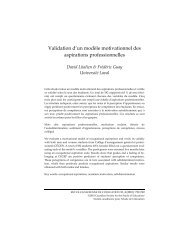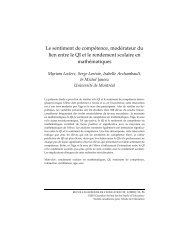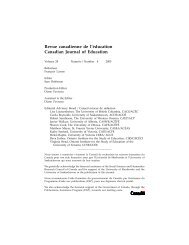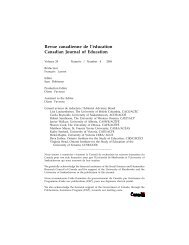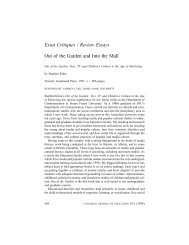Mireille Falardeau et Michel Loranger Le choix de stratégies ... - CSSE
Mireille Falardeau et Michel Loranger Le choix de stratégies ... - CSSE
Mireille Falardeau et Michel Loranger Le choix de stratégies ... - CSSE
Create successful ePaper yourself
Turn your PDF publications into a flip-book with our unique Google optimized e-Paper software.
Art, Imagination, and Teaching:<br />
Researching the High School Classroom<br />
Stuart Richmond<br />
simon fraser university<br />
Process/product-style research into effective teaching has ignored what it means to be a<br />
good art teacher. Imagination as a quality of good teaching has similarly been ignored.<br />
I argue for the essentially imaginative nature of artistic production and appreciation, and<br />
show how this influences the art teacher’s role. As well, I <strong>de</strong>velop a conceptualization of<br />
imaginative art teaching to gui<strong>de</strong> the qualitative investigation of art teaching in six high<br />
school classrooms.<br />
<strong>Le</strong>s recherches sur les processus <strong>et</strong> les produits relatifs à un enseignement efficace font<br />
abstraction <strong>de</strong>s qualités que doit avoir un bon enseignant d’arts plastiques. On oublie<br />
également l’importance <strong>de</strong> l’imagination dans un enseignement <strong>de</strong> qualité. L’auteur<br />
soutient que la production <strong>et</strong> l’appréciation artistiques sont essentiellement <strong>de</strong> nature<br />
imaginative <strong>et</strong> explique comment cela influe sur le rôle <strong>de</strong> l’enseignant d’art plastiques.<br />
Il élabore en outre une théorie <strong>de</strong> l’enseignement <strong>de</strong>s arts plastiques axé sur l’imagination,<br />
théorie servant <strong>de</strong> gui<strong>de</strong> pour l’évaluation qualitative <strong>de</strong> l’enseignement <strong>de</strong>s arts plastiques<br />
dans six classes au secondaire.<br />
And if we <strong>de</strong>ny our imagination, and have no imaginative life, we are poor worms<br />
who have never lived. — D.H.Lawrence (1929/1988)<br />
What constitutes good teaching in any educational sphere is, in the end, both a<br />
philosophical and an empirical matter. It is the normative concept taken as a<br />
gui<strong>de</strong> that enables observers to distinguish and make judgements about good<br />
teaching. Looking to the diversity of practice in individual classrooms gives rich<br />
contextual meaning to theory. On this account, the philosopher’s skills can<br />
fruitfully mesh with those of the empirical researcher. The research project I<br />
<strong>de</strong>scribe here attempts such a convergence. In discussing the purposes, m<strong>et</strong>hodology,<br />
and conclusions of my qualitative study of high school art teaching in six<br />
different urban and suburban classrooms, I emphasize the conceptualization and<br />
investigation of imaginative art teaching.<br />
BACKGROUND CONSIDERATIONS<br />
There is surely som<strong>et</strong>hing remiss about any conception of teaching in an educational<br />
context that fails to find a place for the exercise of the teacher’s creative<br />
366 CANADIAN JOURNAL OF EDUCATION 18:4 (1993)



